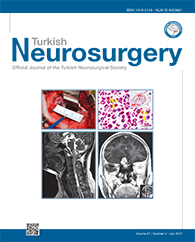2Fatih University, Faculty of Engineering, Department of Genetics and Bioengineering, Istanbul, Turkey
3Bezmialem Vakif University, Department of Histology and Embriology, Istanbul, Turkey
4Istanbul Research and Training Hospital, Neurosurgery Clinic, Istanbul, Turkey
5Bezmialem Vakif University, Department of Neurology, Istanbul, Turkey DOI : 10.5137/1019-5149.JTN.16772-15.3 AIM: Current stroke therapies include lipid-lowering drugs, which reduce inflammation and serve to stabilize the atherosclerotic plaque to demonstrate better outcome and neuroprotection. Peroxisome proliferator activated receptors (PPAR) ? regulates lipid homeostasis and is a target of fibrates, which have a neuroprotective function by various mechanisms. In this study, we aimed to evaluate the role of the PPAR? agonist, fenofibrate, in the modulation of cleaved caspase-3 immunoreactivity and at the final infarct volume in an experimental ischemia/reperfusion rat model by induced transient proximal middle cerebral artery occlusion.
MATERIAL and METHODS: A total of 65 male Sprague Dawley rats were allocated into 4 groups; sham (n =5), experiment 1 (n=20), experiment 2 (n=20), experiment 3 (n=20). All experiment groups were divided to 3 subgroups in order to evaluate the final infarct volume at 24th hour (n=5) and the immunoreactivity of cleaved caspase -3 at different time periods [at first hour (n=5), at 6th hour (n=5), at 24th hour (n=5)] after transient middle cerebral artery occlusion (MCAo). At the study, the experiment groups (Experiment 1 and Experiment 2) were received the fenofibrate-diet during 14 days before ischemia procedure. All animals were sacrificed at 24th hours after MCAo. Infarction volumes were calculated from 2,3,5,triphenyltetrozolium chloride (TTC)- stained brain sections.
RESULTS: We found that fenofibrate-therapy reduced significantly more body weight than the other experiment groups (p<0.05). At the time intervals, a decrease of immunoreactivity of cleaved caspase-3 was significantly observed with fenofibrate therapy after MCAo (p<0.05). Chronic fenofibrate treatment before cerebral ischemia significantly reduced the infarction size after MCAo compared with the other groups (respectively; p = 0.011 and p< 0.000).
CONCLUSION: Fenofibrate treatment has neuroprotective effects on middle cerebral artery infarcts.
Keywords : Neuroprotection, Fenofibrate, Stroke, Caspase-3




